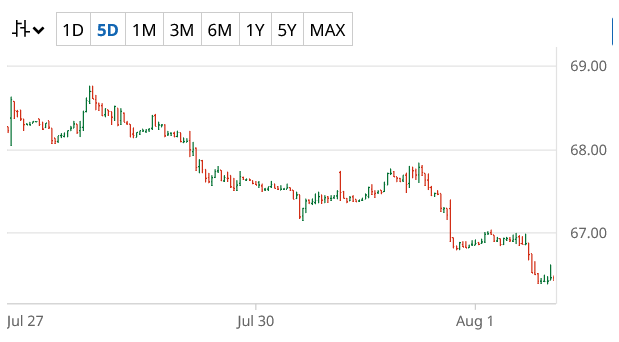The week ending Friday, August 1 saw ICE cotton futures stumble and then stair-step lower (see chart above courtesy of Barchart.com). ICE Dec’25 cotton settled Friday at 66.36 cents per pound, while Dec’26 settled at 68.47 cents. Chinese cotton prices declined across the week, as did the A-Index of world prices.
The week ending August 1 saw different commodity futures followed different paths. CBOT corn futures changed from a down-trend into a sideways-to-higher trend. CBOT soybeans changed from a slight down-trend into a modestly steeper down-trend. KC wheat futures followed a widely gyrating sideways pattern. ICE WTI crude oil futures rose steadily before leveling off. The U.S. dollar index climbed steadily across the week before sharply resetting Friday in the wake of a weak U.S. jobs report. Other macro influences (i.e., GDP, inflation, and interest rate policy) remained mixed in their expectation and implication for slow economic growth.

Cotton-focused market influences this week saw continued weekly reports of very light to moderate regional demand for U.S. cotton. There were continued low level 2024/25 U.S. export net sales for the week ending July 24 mostly due to reportedly light supplies at the end of the marketing year. More significantly, weekly net sales for the 2025/26 marketing year were very modest at only 71,700 bales of upland, which has clearer implications for poor demand. The pace of 2024/25 export shipments continued above the weekly average level needed to reach USDA’s target level of exports (11.5 million bales).
All of the projected U.S. old crop production has been ginned and classed since April. New crop influences included patchy showers over parts of Texas, as well as scattered showers over the Gulf states, and the Southeast. On the other side of the world, the precocious Indian monsoon has brought above average rains that have likely increased plantings of summer sewn crops, including cotton. The second half of the monsoon season is forecasted to be average in August and above average in September. This could boost Indian and Pakistani production, perhaps at the expense of demand for U.S. exports.
For the week ending July 31, the day-to-day shifts in ICE cotton open interest started off slightly declining, then moderately increased. Daily price settlements were flat-to-lower, giving the appearance of outright short positioning. Indeed, the regular weekly (Tuesday, July 29) snapshot of speculative open interest showed aggregate short positioning with 1,178 extra hedge fund short positions, reinforced by 289 fewer hedge fund longs, as well as a 924 contract shrinkage in the index trader net long position, week over week.
The dynamics of ICE cotton futures may also represent a wet blanket on the market. It remains true that unfixed call sales (by mills) are at an historically low level, perhaps reflecting the cautionary buying on the demand side. In terms of ratios, unfixed call purchases (by suppliers) outweigh unfixed call sales by two-fold across all contracts, as of July 25.
For more details and data on Old Crop and New Crop fundamentals, plus other near term influences, follow these links (or the drop-down menus above) to those sub-pages.
Πηγή: TAMU

